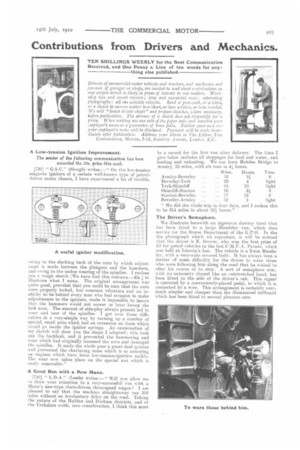Contributions from Drivers and Mechanics.
Page 19

If you've noticed an error in this article please click here to report it so we can fix it.
TEN SHILLINGS WEEKLY for the Best Communication Received, and One Penny a Line of ten words for any thing else published.
Drivers of commercial-motor vehicles and tractors, and mechanics and foremen of garages or shops, are invited to send short contributions on any subject which is likely to prove of interest to our readers. Workshop tips and smart repairs ; long and successful runs; interesting Photographs : all are suitable subjects. Send a post-card, or a letter, or a sketch to us—no ;natter how short, or how written, or how worded. We will "knock it into shape" and prepare sketches, where necessary. before publication. The absence of a sketch does not disqualify for a prize. W hen writing use one side of the paper only and mention your employer's name as a guarantee of bona fides. Neither your own nor your employer's namc will be disclosed. Payment will be made .immedialely after publication. Address your letters to The Editor, THE COMMERCIAL MOTOR, 7-15, Rosebery Avenue, London, E.C.
A Low-tension Ignition Improvement.
The sender of the following communication has been awarded the 10s. prize this week.
[739; " G.S.C." (Slough) writes :—" On the low-tension magneto igniters of a certain well-known type of petroldriven motor chassis, I have experienced a lot of trouble.
owing to the slacking back of the nuts by which adjustment is made between the plungers and the hammers, and owing to the undue wearing of the spindles. I enclose you it rough sketch [We have had this redrawn—En.] to illustrate what I mean. The original arrangement was finite good, provided that you could be sure that the nuts were properly locked, but constant vibration and an inability to be behind every man who had occasion to make adjustments to the igniters, made it impossible to insure that the hammers would not sooner or later loosen the lock nuts. The amount of side-play always present led to wear and tear of the spindles. I got over these difficulties in a very-simple way by turning up a number of special, small nuts which had an extension on them which would go inside the igniter springs. An examination of my sketch will show you the shape I adopted ; this took out the backlash, and it prevented the hammering and wear which had originally loosened the nuts and damaged the spindles. It made the whole gear a great deal quieter and prevented the chattering noise which is so annoying on engines which have loose low-tension-ignition tackle. The wear now takes place on the special nut which is easily removable."
A Good Run with a New Mann.
[740.) " L.D.A." (Leeds) writes:—" Will you allow me to draw your attention to a very-successful run with a Mann's new-type chain-driven three-speed wagon? I am pleased to say that the machine straightaway ran 318 miles without an involuntary delay on the road. Taking the nature of the Halifax and Durham districts, and of the Yorkshire wolds, into consideration, I think this must be a record for the. first run after delivery. The time I give below includes all stoppages for food and water, and loading and unloading. We ran from Haden Bridge to Armley, 24 miles, with six tons in 4,1 hours.
" We did the whole trip in four days, and I reckon this to be 314 miles in about 521 hours."
The Driver's Semaphore.
We illustrate herewith an ingenious dummy hand that has been fitted to a large Maudslay van, which does service for the Stores Department of the G.P.O. In the the photograph which we reproduce, it will be noticed that the driver is E. Grover, who won the first prize of D'i for petrol vehicles in the last C.111.U.A. Parade, which was held at Lincoln's Inn. The vehicle is a 3-ton Maudslay, with a very-wide covered body. It has always been a matter of some difficulty for the driver to warn those who were following him along the mad that he wished to alter his course or to stop. A sort of semaphore arm, with its extremity shaped like an outstretched hand, has been fitted to the side of the driver's cab. This signal is operated by a conveniently-placed pedal, to which it is connected by a. wire. This arrangement is certainly verymuch simpler and cheaper than the illuminated tailboard which has been fitted to several pleasure ears.




















